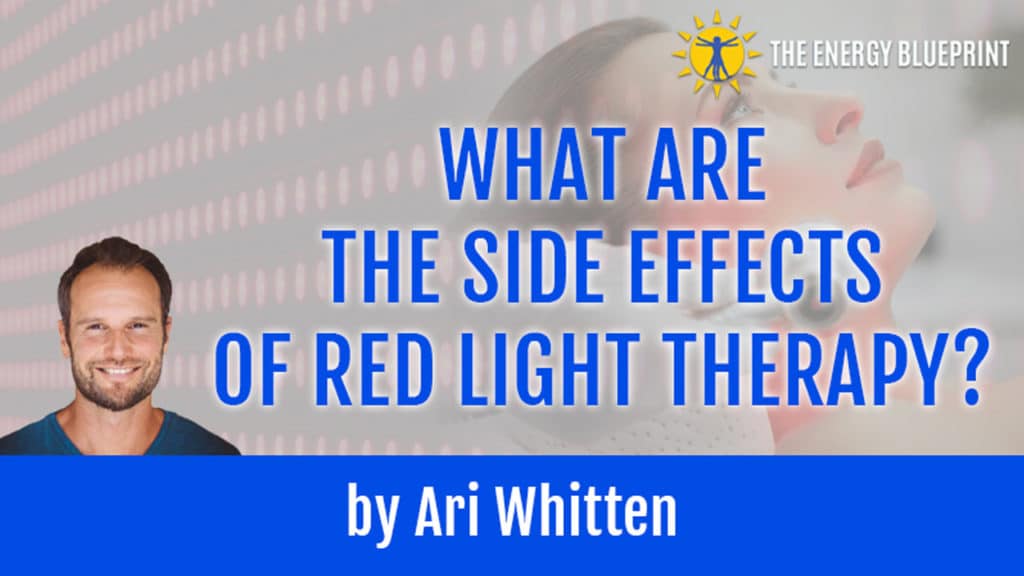
Red light therapy is a therapeutic technique that uses low-level wavelengths of light to treat a number of conditions, from pain relief to anti-aging.
As a safe and minimally invasive solution, infrared light offers an effective alternative to traditional drugs as a method of healing wounds and reducing the pain of inflammation. low-level light therapy is FDA-approved for treating conditions like chronic joint pain, hair loss, and may even help repair brain tissue.
But what about the possible side-effects? First, it’s important to take a look at the beginnings of red light therapy.
The Beginnings of Red Light Therapy
In the early 1990s, NASA began studying red light spectrums in order to determine the beneficial effects on growing food in space. 1 The researchers found that the intense light from red light-emitting diodes (LEDs) helped promote the growth of plant cells.
These findings were intriguing and researchers around the world took note. Increasing amounts of research were then devoted to the effects of red light on organisms. Specifically, the wavelengths of light were found to have a positive effect on living tissue.
The basic process of red light and near-infrared (NIR) infrared therapy involves exposure to red and NIR light by means of low light lasers or LED lights. The process is known by many names, including:
- photobiomodulation (PBM)
- low-level light therapy (LLLT)
- soft laser therapy
- cold laser therapy
- biostimulation
- photonic stimulation
- low-power laser therapy (LPLT)
The Effects of Red Light on Bio Organisms
Research supports that specific light wavelengths cause a biochemical effect in cells that boost the energy production of mitochondria. A study in the journal Seminars in Cutaneous Medicine and Surgery notes, mitochondria in the skin cells can absorb these light particles, boosting a cell’s energy with the creation of adenosine triphosphate (ATP). 2
You can think of the mitochondria as the powerhouse of the cell. By increasing ATP production, the cell has more energy to function more efficiently and repair damage.
LED light therapy is also thought to contribute to building up the cell’s antioxidant and anti-inflammatory defense systems.
When red light therapy is used with medications such as lithium, melatonin, phenothiazine antipsychotics and certain antibiotics, it’s referred to as photodynamic therapy. In this type of therapy, light is only used as an activating agent.
Red Light Therapy vs. Medications
Inflammation is generally treated with medications, which can have serious side-effects. The use of red light therapy in treating inflammation without the side-effects of traditional medications is showing great promise.
NSAIDs
Over the counter varieties of NSAIDs (non-steroidal anti-inflammatory drugs) include aspirin, ibuprofen (Advil), and naproxen (Aleve). According to the Cleveland Clinic, common side effects of NSAIDs include:
- Stomach pain and heartburn
- Stomach ulcers
- A tendency to bleed more, especially when taking aspirin. Your doctor might tell you to stop taking NSAIDs before surgery. Ask your doctor before taking NSAIDs if you are on blood-thinning medications (such as Coumadin).
- Headaches and dizziness
- Ringing in the ears
- Allergic reactions such as rashes, wheezing, and throat swelling
- Liver or kidney problems. If you have any kidney problems, you shouldn’t take NSAIDs without checking with your doctor.
- High blood pressure
- Leg swelling
- Gas
- Feeling bloated
- Nausea
- Vomiting
- Diarrhea and/or constipation 3

Steroids
The use of steroids is often a treatment for fighting inflammation. Steroids decrease inflammation and suppress the immune system, which is helpful when it starts attacking healthy tissue.
But long-term use of steroids can lead to vision problems, high blood pressure, and osteoporosis. When prescribing steroids, your doctor will weigh the benefits and risks with you.
Supplements
Some supplements have shown promise in treating inflammation, including fish oil, lipoic acid, and curcumin. Several spices are also noted for relieving inflammation, including ginger, garlic, turmeric, and cayenne.
Efficacy and Safety of Red Light Therapy
Red light therapy doesn’t cause damage to the skin’s surface, which differs from laser or intense pulsed light (IPL) therapy. Light wavelengths work by causing damage to the outer layer of skin, inducing tissue repair. Differently, red light penetrates only about 5 millimeters into the skin, directly stimulating cell regeneration and collagen production.
Full-spectrum light can result in sunburns if the light does not have a diffuser which filters out the ultraviolet wavelengths. Lamps used in modern light therapy that filter out ultraviolet rays are considered to be safer, but caution should be used for photodynamic therapy.
As noted in News-Medical.net, “When photodynamic therapy is pursued, physical hazards such as non-ionizing radiation produced by the light-emitting device and chemical hazards such as undesirable exposure to photosensitizing agents applied to patients must be considered for safe use by the healthcare professional.” 4
How Red Light Therapy Works for Cancer Treatment
In a study examining the effects of red light therapy on tumor growth, it was found that treatments showed some promise without presenting safety concerns. 5
“The present study failed to demonstrate a harmful effect of whole-body red light on tumor growth in an experimental model of UV-induced SCC. There was a transient and small reduction in relative tumor area in the treatment group compared with controls. This study suggests that LLLT should not be withheld from cancer patients on an empiric basis.”
Treatment of Skin Conditions
A 2014 study examined the safety of red light therapy in treating a number of skin conditions that require a reduction of inflammation while studying the safety of the treatments. The researchers concluded:
“In pigmentary disorders such as vitiligo, LLLT can increase pigmentation by stimulating melanocyte proliferation and reduce depigmentation by inhibiting autoimmunity. Inflammatory diseases such as psoriasis and acne can also benefit. The non-invasive nature and almost complete absence of side-effects encourages further testing in dermatology.”
Are There Medical Conditions Tied to Red Light Therapy?
There are no studies tied directly to the use of red light therapy and those who experience photosensitivity reactions, it is recommended that you do a skin sensitivity test before undergoing any light therapy. 6
Individuals react differently to exposure to light. While most have no reaction, some may develop excessive redness or irritation. If you notice any redness, irritation, itchiness, or other reactions, it is suggested that you contact the device manufacturer and consult with your healthcare professional.
Typically any redness or irritation will disappear within a few hours or days. However, any painful reaction that does not disappear in this time should be reported to your doctor.
If you are taking any medications, it is recommended that you consult with your doctor before beginning any new light regimen to ensure there won’t be adverse reactions. Certain antibiotics and medications make you extra sensitive to light.
Basic Safety for Red Light Treatments
With any source of light, staring directly at the bulbs may cause eye strain that can induce headaches, migraines, or nausea. Glare from LED bulbs may also cause discomfort. In any setting where light therapy is being administered, it is recommended to wear protective eyewear.
Additional Benefits of Red Light Therapy
The safe and minimally invasive nature of red light therapy treatment is continuing to be studied. Healthline notes the promising benefits of red light and NIR light treatments:
- promotes wound healing and tissue repair
- improves hair growth in people with androgenic alopecia
- help for the short-term treatment of carpal tunnel syndrome
- stimulates healing of slow-healing wounds, like diabetic foot ulcers
- reduces psoriasis lesions
- aids with short-term relief of pain and morning stiffness in people with rheumatoid arthritis
- reduces some of the side effects of cancer treatments, including oral mucositis
- improves skin complexion and builds collagen to diminish wrinkles and fine lines
- helps to mend sun damage
- prevents recurring cold sores from herpes simplex virus infections
- improves the health of joints in people with degenerative osteoarthritis of the knee
- helps diminish scars
- relieves pain and inflammation in people with pain in the Achilles’ tendons 7
Low-level laser therapy is showing promise for improving brain health, including memory, as well as treating brain diseases and injuries. It has been demonstrated to reduce inflammation and speed healing processes, as well as showing positive results for other medical conditions and the general promotion of health.
If you are interested in investigating red light therapy, it is always best to consult with your healthcare professional or dermatologist to discuss your options. You can check out my blog on the best red light therapy devices here as well as how to use red light therapy at home.
References[+]
| ↑1 | Herridge, L, (2012). LED Lights Used in Plant Growth Experiments for Deep Space Missions. NASA. 2012 Sept 11. |
|---|---|
| ↑2, ↑5 | Arvi, P, et. al. (2013). Low-level laser (light) therapy (LLLT) in skin: stimulating, healing, restoring. Semin Cutan Med Surg. 2013 Mar; 32(1): 41–52. |
| ↑3 | Non-Steroidal Anti-Inflammatory Medicines (NSAIDs). Cleveland Clinic. |
| ↑4 | Meštrović, T, (2018). Light Therapy Safety and Side Effects. News Medical Life Sciences. 2018 Aug 23. |
| ↑6 | Red Light Therapy and Adverse Side Effects. Trophy Skin. |
| ↑7 | Cafasso, J, (2018). Red Light Therapy Benefits. Health Line. 2018 May 11. |




